In the realm of modern living, smart home upgrades have emerged as a transformative force, reshaping our homes into intelligent, connected havens. From automating mundane tasks to enhancing security and entertainment, these upgrades offer a myriad of benefits that redefine the way we interact with our living spaces.
As technology continues to advance, the possibilities for smart home integrations are boundless. Embark on a journey into the world of smart home upgrades, where convenience, efficiency, and personalization converge to create a truly exceptional living experience.
Smart Home Basics
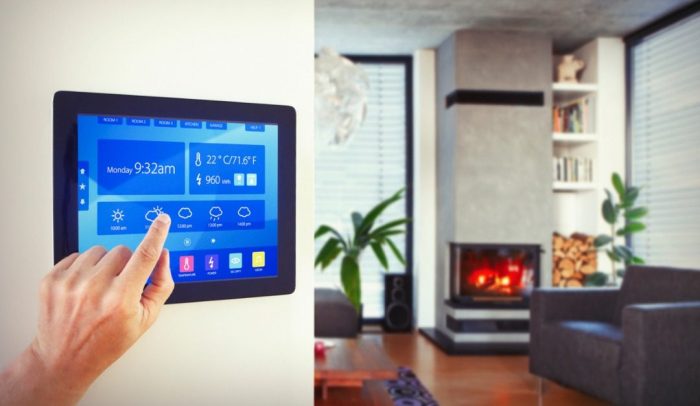
A smart home is a modern residence equipped with connected devices that can be controlled and automated through a central system. This integration allows for enhanced convenience, energy efficiency, and security.
The seamless integration of smart devices is essential for a cohesive smart home ecosystem. This interconnectedness enables devices to communicate with each other and respond to commands from a single control center.
Popular Smart Home Devices
The smart home market offers a diverse range of devices that cater to various needs and preferences. Some commonly adopted smart home devices include:
- Smart Thermostats: These devices optimize heating and cooling systems, allowing for efficient energy consumption and temperature control.
- Smart Lighting: Smart lighting systems provide customizable lighting options, including adjustable brightness, color, and scheduling.
- Smart Speakers: Voice-activated smart speakers, like Amazon Echo and Google Home, enable hands-free control of smart devices and provide access to information, music, and other entertainment.
- Smart Security Systems: Smart security systems offer enhanced home protection through motion sensors, door and window sensors, and remote monitoring capabilities.
- Smart Appliances: From refrigerators to washing machines, smart appliances can be remotely controlled, monitored, and programmed for efficient operation.
Home Automation and Connectivity
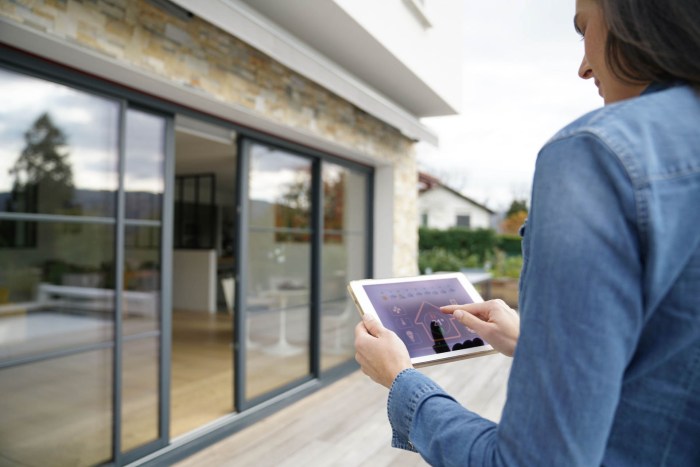
Smart homes rely on automation and connectivity to create a seamless and convenient living environment. Home automation involves the use of technology to control various aspects of the home, such as lighting, heating, and security, while connectivity refers to the ability of these devices to communicate with each other and with the user.
Connectivity Options
There are several connectivity options available for smart home devices, each with its own advantages and disadvantages:
- Wi-Fi: Wi-Fi is a wireless technology that allows devices to connect to the internet and to each other. It is widely available and offers good range and speed. However, it can be susceptible to interference and may not be suitable for devices that require a very reliable connection.
- Bluetooth: Bluetooth is a wireless technology that allows devices to connect to each other over short distances. It is commonly used for connecting devices such as smartphones, speakers, and headphones. Bluetooth is reliable and easy to set up, but it has a limited range and can only connect a small number of devices at once.
- Zigbee: Zigbee is a wireless technology specifically designed for smart home devices. It is a low-power, low-bandwidth technology that is designed to be reliable and energy-efficient. Zigbee devices can form a mesh network, which means that they can communicate with each other even if they are not directly connected to the hub.
Creating a Seamless Smart Home Network
To create a seamless smart home network, it is important to consider the following tips:
- Choose the right connectivity option: Consider the range, speed, and reliability requirements of your devices when choosing a connectivity option.
- Use a central hub: A central hub can help to simplify the management of your smart home devices and ensure that they are all communicating with each other properly.
- Use a consistent brand of devices: Using devices from the same brand can help to ensure compatibility and simplify the setup process.
- Keep your devices updated: Regularly updating your smart home devices with the latest firmware can help to improve their performance and security.
Smart Lighting
Smart lighting systems revolutionize home lighting by enabling remote control, color customization, and energy efficiency. These systems offer convenience, enhanced ambiance, and potential cost savings.
Types of Smart Lights
Smart lighting encompasses various types of devices, including LED bulbs and smart switches. LED bulbs are energy-efficient and can be controlled individually or in groups, while smart switches allow you to control traditional lights from a smartphone or voice assistant.
Smart Lighting Applications
Smart lighting systems have a wide range of applications. They can be used to set timers, create custom lighting scenes, and adjust brightness levels. Some systems even allow you to control lighting based on your location or time of day.
Color Customization
One of the most appealing features of smart lighting is the ability to customize colors. You can choose from a wide range of colors to create the perfect ambiance for any occasion, whether you’re hosting a party or simply relaxing at home.
Smart Thermostats and Energy Management
Smart thermostats have revolutionized home energy management, providing homeowners with greater control over their heating and cooling systems. By utilizing advanced technology, smart thermostats optimize energy usage, reduce utility bills, and enhance comfort levels.
Programmable Schedules
Smart thermostats feature programmable schedules that allow homeowners to set specific temperatures for different times of the day. This flexibility enables efficient energy usage by lowering the temperature during unoccupied hours and raising it when occupants return home. The programmability ensures that heating and cooling systems operate only when necessary, reducing energy waste.
Remote Control and Connectivity
Smart thermostats offer remote control capabilities through smartphone apps or web interfaces. This connectivity allows homeowners to adjust temperatures, monitor energy consumption, and receive notifications about system status from anywhere with an internet connection. Remote control provides added convenience and the ability to make adjustments on the go, further enhancing energy efficiency.
Energy-Saving Tips
To maximize energy savings with smart thermostats, consider the following tips:
- Set Realistic Temperatures: Avoid extreme temperature settings, as small adjustments can significantly impact energy usage. Aim for comfortable temperatures that align with your lifestyle.
- Utilize Setback Periods: Program your thermostat to lower the temperature during unoccupied hours, such as when you’re at work or asleep. This simple step can save a substantial amount of energy.
- Optimize Heating and Cooling Cycles: Adjust the thermostat to minimize the number of heating or cooling cycles per hour. Longer cycles are more efficient and reduce energy consumption.
- Monitor Energy Usage: Smart thermostats often provide detailed energy usage reports. Regularly review these reports to identify areas where you can further optimize energy efficiency.
Smart Security and Surveillance
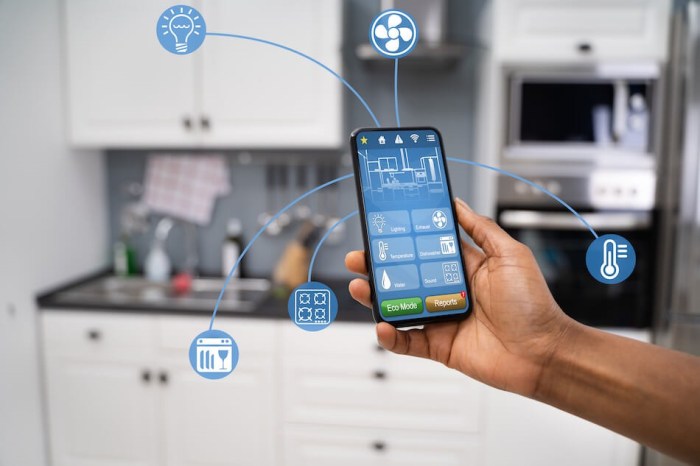
In an increasingly connected world, smart security systems are becoming essential for protecting homes and families. These systems utilize advanced technology to deter crime, monitor activity, and provide peace of mind.
Types of Smart Security Devices
Smart security systems incorporate a range of devices that work together to enhance home security. Common components include:
- Motion Sensors: Detect movement within a designated area, triggering alarms or sending notifications.
- Smart Locks: Allow homeowners to lock and unlock doors remotely, monitor entry and exit, and grant access to authorized individuals.
- Security Cameras: Provide live footage and recorded video of a property, enabling remote monitoring and incident verification.
- Glass Break Sensors: Detect the sound of breaking glass, alerting homeowners to potential break-ins.
- Smart Doorbells: Equipped with cameras and motion sensors, smart doorbells allow homeowners to see and communicate with visitors from anywhere.
Smart Security Features
Smart security systems offer a variety of features that enhance home protection and convenience:
- Remote Monitoring: Access and control the security system from anywhere via a smartphone or tablet.
- Alerts and Notifications: Receive real-time alerts and notifications on your mobile device when sensors are triggered or security breaches occur.
- Geofencing: The system can automatically arm or disarm based on the location of your smartphone.
- Integration with Other Smart Home Devices: Smart security systems can be integrated with other smart home devices, such as lights and thermostats, to create a comprehensive home automation system.
- Professional Monitoring: Some systems offer professional monitoring services, where a security company monitors the system and dispatches emergency responders if necessary.
Smart Entertainment and Media
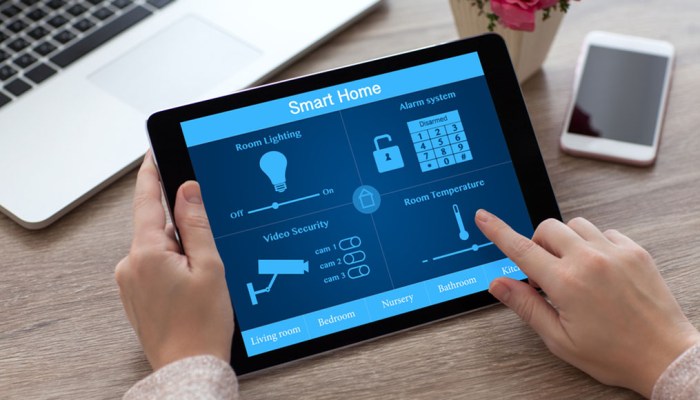
Integrating smart technology into your home’s entertainment and media setup enhances your viewing and listening experience. It offers seamless control, personalized recommendations, and a more immersive entertainment environment.
Smart TVs and Streaming Devices
Smart TVs combine internet connectivity and streaming capabilities with traditional television functions. Access streaming platforms, online content, and apps directly from your TV without the need for external devices. Streaming devices like Roku, Amazon Fire TV, and Apple TV provide similar functionality, turning non-smart TVs into smart ones.
Integration of Smart Speakers and Voice Assistants
Smart speakers like Amazon Echo and Google Home integrate voice control into your home entertainment system. Use voice commands to control smart TVs, streaming devices, and music playback. Ask for personalized recommendations, adjust volume, or switch channels, all hands-free.
Smart Home Entertainment Setups
Smart home entertainment setups connect various smart devices to create a cohesive and immersive experience. For example, you can sync smart lights to change colors and brightness based on the content you’re watching, or use smart thermostats to adjust the room’s temperature for optimal comfort.
Multi-room Audio Systems
Multi-room audio systems distribute music throughout your home, allowing you to play the same or different music in different rooms. Controlled by a central hub or app, these systems let you create zones, adjust volume, and switch songs from anywhere in the house.
Smart Kitchen Appliances
Smart kitchen appliances are revolutionizing the way we cook and manage our kitchens. From refrigerators that keep track of your groceries to ovens that can be controlled with your voice, these appliances offer a range of benefits that can make cooking more efficient, convenient, and enjoyable.
One of the biggest advantages of smart kitchen appliances is their ability to be remotely controlled. This means you can start or stop cooking, adjust temperatures, and even preheat your oven from anywhere with an internet connection. This can be especially useful if you’re running late from work or if you want to get a head start on dinner while you’re still out and about.
Voice Control
Many smart kitchen appliances also feature voice control, allowing you to operate them with simple voice commands. This can be especially helpful if you’re multitasking or if you have your hands full. For example, you can ask your smart refrigerator to add milk to your shopping list or ask your smart oven to preheat to 350 degrees Fahrenheit.
Recipe Integration
Some smart kitchen appliances even come with built-in recipe integration. This means you can find recipes, follow instructions, and even control your appliances all from the same device. This can make cooking more convenient and help you create delicious meals with ease.
Examples and Impact
Here are some examples of smart kitchen appliances and how they can impact your cooking efficiency:
- Smart refrigerators: These appliances can track your groceries, suggest recipes based on what you have on hand, and even order groceries for you when you’re running low. They can also be used to create shopping lists, set expiration dates, and keep track of your family’s dietary needs.
- Smart ovens: Smart ovens can be controlled with your voice, smartphone, or tablet. They can also be programmed to cook specific dishes, so you can simply set it and forget it. Some smart ovens even come with built-in cameras that allow you to monitor your food while it’s cooking.
- Smart dishwashers: Smart dishwashers can be scheduled to run at specific times, so you can take advantage of off-peak electricity rates. They can also be monitored remotely, so you can see how much time is left in the cycle and get notified when it’s finished.
Overall, smart kitchen appliances can make cooking more efficient, convenient, and enjoyable. By automating tasks and providing a range of features, these appliances can help you save time, reduce stress, and create delicious meals with ease.
Smart Home Maintenance and Troubleshooting
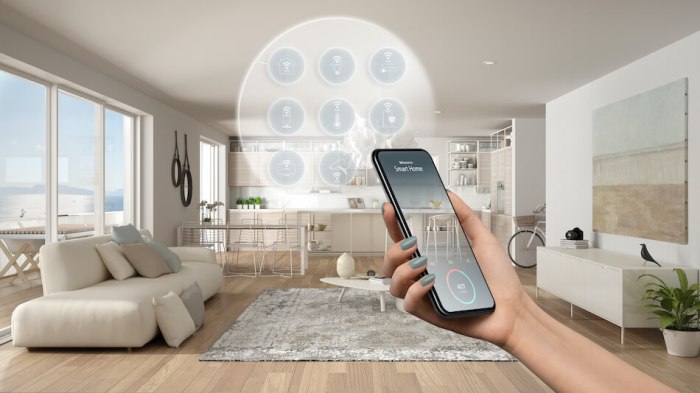
Smart home systems require regular maintenance to ensure optimal performance and longevity. By addressing potential issues proactively, you can prevent disruptions and keep your smart home running smoothly.
Troubleshooting Common Smart Home Issues
Troubleshooting smart home issues involves identifying the root cause and implementing appropriate solutions. Common problems include:
- Connectivity Issues: Ensure a stable internet connection, check router settings, and update firmware.
- Device Compatibility: Verify compatibility between devices and the smart home platform. Update device drivers and software.
- App Functionality: Check for app updates, clear app cache and data, and ensure proper device permissions.
- Security Concerns: Implement strong passwords, enable two-factor authentication, and regularly update device firmware.
- Device Responsiveness: Restart devices, check battery levels, and ensure devices are within range of the network.
Keeping Smart Home Devices Updated and Secure
Regular updates are crucial for maintaining device functionality and security.
- Firmware Updates: Install firmware updates to address bugs, improve performance, and enhance security.
- App Updates: Update smart home apps to access new features, bug fixes, and security improvements.
- Security Patches: Apply security patches promptly to protect devices from vulnerabilities and cyber threats.
- Strong Passwords: Use strong, unique passwords for smart home accounts and devices.
- Two-Factor Authentication: Enable two-factor authentication for added security.
Regular maintenance and troubleshooting ensure your smart home system operates reliably and securely, enhancing your convenience and peace of mind.
Cost Considerations and ROI
The financial implications of implementing smart home upgrades can vary depending on the specific devices, features, and scope of the project. While there is an initial investment required, the potential return on investment (ROI) can be substantial in terms of energy savings, convenience, and enhanced security.
Initial Investment and Ongoing Costs
The initial investment for smart home upgrades can range from a few hundred dollars for basic devices like smart light bulbs or thermostats to several thousand dollars for more comprehensive systems. Ongoing costs may include subscription fees for cloud services, maintenance, and repairs.
It’s important to carefully consider the upfront and ongoing costs to ensure that the investment aligns with your budget and long-term goals.
Potential ROI
The potential ROI of smart home upgrades can be significant. Energy-efficient devices can reduce utility bills, while smart thermostats and lighting systems can optimize energy usage. Enhanced security measures can provide peace of mind and potentially lower insurance premiums. The convenience and comfort offered by smart home features can also improve the quality of life and productivity.
Budgeting and Prioritization
To make smart home upgrades affordable and effective, it’s essential to create a budget and prioritize your needs. Start by identifying the areas where you want to make improvements, such as energy efficiency, security, or entertainment. Research different smart home devices and systems to compare features, costs, and compatibility.
Consider starting with a few key upgrades and gradually expanding your system over time.
Future Trends and Innovations
The realm of smart home technology is in a constant state of evolution, with new trends and innovations emerging at a rapid pace. Artificial intelligence (AI) and machine learning (ML) are at the forefront of this transformation, enabling smart homes to become increasingly intelligent and responsive to the needs of their occupants.
AI and ML in Smart Homes
AI and ML algorithms are revolutionizing the way smart homes operate. These technologies enable devices to learn from patterns and adapt their behavior accordingly, providing a more personalized and intuitive user experience. For instance, AI-powered thermostats can analyze a household’s energy usage patterns and adjust the temperature settings to optimize comfort and efficiency.
Cutting-Edge Smart Home Devices and Concepts
The future of smart homes holds exciting possibilities, with innovative devices and concepts pushing the boundaries of what’s possible. Some examples include:
- Self-healing homes: These homes utilize advanced materials and technologies to detect and repair damage autonomously, enhancing durability and longevity.
- Holographic interfaces: Imagine controlling your smart home with holographic projections that respond to gestures and voice commands, creating an immersive and futuristic user experience.
- Smart appliances with built-in AI: Refrigerators that can suggest recipes based on the ingredients you have, ovens that adjust cooking settings based on the type of food, and washing machines that optimize cycles based on fabric type are just a few examples of how AI can enhance the functionality of household appliances.
Closing Summary
As we stand at the cusp of a new era in home automation, the potential for smart home upgrades to revolutionize our living experiences is limitless. By embracing these technological advancements, we unlock a world of possibilities that enhance our comfort, security, and entertainment.
As we move forward, let us continue to explore the frontiers of smart home innovation, embracing the transformative power of technology to create homes that are truly intelligent, responsive, and an extension of our modern lifestyles.
FAQs
Q: What are the primary benefits of smart home upgrades?
A: Smart home upgrades offer a multitude of advantages, including enhanced convenience, increased energy efficiency, heightened security, and personalized entertainment experiences.
Q: How do smart thermostats contribute to energy savings?
A: Smart thermostats optimize energy usage by learning your heating and cooling preferences, creating programmable schedules, and allowing remote control, resulting in reduced energy consumption and lower utility bills.
Q: What types of smart security devices are available?
A: Smart security systems encompass various devices such as motion sensors, smart locks, surveillance cameras, and smart doorbells, providing comprehensive protection against intruders and ensuring the safety of your home and loved ones.
Q: How do smart kitchen appliances enhance cooking efficiency?
A: Smart kitchen appliances revolutionize cooking by offering features like remote control, voice commands, recipe integration, and automated cooking programs, streamlining the cooking process and making meal preparation more convenient and enjoyable.
Q: What emerging trends are shaping the future of smart homes?
A: The future of smart homes is being shaped by advancements in artificial intelligence (AI) and machine learning (ML), enabling devices to learn user preferences, anticipate needs, and provide personalized experiences. Additionally, the integration of IoT (Internet of Things) devices is expanding the connectivity and functionality of smart homes.